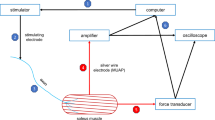Abstract
Bundles of 20–30 fast muscle fibres were isolated from the abdominal myotomes of the short-horned sculpin (Myoxocephalus scorpius L.). The energy cost of contraction was measured during oscillatory work at 4 °C and 15 °C following treatment with iodoacetate and nitrogen gas to block glycolysis and aerobic metabolism. Isolated fibres were subjected to sinusoidal length changes about in situ resting length and stimulated at a selected phase in the strain cycle. Preliminary experiments with untreated preparations established the strain amplitude and stimulation parameters required to maximize work output over a range of cycle frequencies at 4 °C and 15 °C. Following oscillatory work, treated preparations were rapidly frozen, freeze-dried and the concentrations of phosphocreatine (PCr), creatine, adenosine 5′-triphosphate (ATP), adenosine 5′- di- and mono-phosphate and inosine 5-monophosphate measured by high performance liquid chromatography. The concentration of PCr declined in proportion to the total work done for up to 64 cycles without a significant change in ATP. Maximum power output was produced at a cycle frequency of 5 Hz at 4 °C (14–18 W/kg) and 17 Hz at 15 °C (23–27 W/kg). The rate of utilization of PCr per cycle was independent of temperature. However, since work per cycle was higher at 4 °C (2.7–3.7 mJ/g wet weight) than 15 °C (1.2–1.6 mJ/g wet weight), the energetic cost of contraction decreased with increasing temperature.
Similar content being viewed by others
References
Altringham JD, Johnston IA (1990) Modelling muscle power output in a swimming fish. J Exp Biol 148:395–402
Altringham JD, Johnston IA (1990) Scaling effects on muscle function: power output of isolated fish muscle fibres performing oscillatory work. J Exp Biol 151:453–467
Aubert X (1956) “Le Couplage Energetique de la Contraction Musculaire.” Arscia, Brussels
Bergmeyer HU (1974) Methods of enzymatic analysis. Academic Press, New York
Cain DF, Davies RE (1962) Breakdown of triphosphate during a single contraction of working muscle. Biochem Biophys Res Commun 8:361–366
Carlson FD and Siger A (1959) The creatine phosphoryltransfer reaction in iodoacetate-poisoned muscle. J Gen Physiol 43:301–313
Curtin NC, Woledge RC (1988) Energetic cost of power output by isolated fibre bundles from dogfish white muscle. J Physiol (Lond) 407:74P
Driedzic WR, Hochachka PW (1976) Control of energy metabolism in fish white muscle. Am J Physiol 230:R579-R582
Fenn WO (1924) The relation between work performed and the energy liberated in muscular contraction. J Physiol (Lond) 58:373–395
Heglund NC, Cavagna GA (1987) Mechanical work, oxygen consumption, and efficiency in isolated frog and rat muscle. Am J Physiol 253:C22-C29
Hess F, Videler JJ (1984) Fast continuous swimming of saithe (Pollachius virens): a dynamic analysis of bending moments and muscle power. J Exp Biol 109:229–251
Hudson RCL (1969) Polyneuronal innervation of the fast muscles of the marine teleost Cottus scorpius L. J Exp Biol 59:47–67
Johnson TP, Johnston IA (1991) Power output of fish muscle fibres performing oscillatory work: effects of acute and seasonal temperature change. 157:409–423
Johnston IA, Altringham JD (1988) Muscle function in locomotion. Nature 335:767–768
Josephson RK (1985) Mechanical power output from striated muscle during cyclical contraction. J Exp Biol 114:493–512
Langfeld KS, Altringham JD, Johnston IA (1989) Temperature and the force-velocity relationship of live muscle fibres from the teleost Myoxocephalus scorpius. J Exp Biol 144:437–448
Van Leeuwen JL, Lankheet MJM, Akster HA, Osse JWM (1990) Function of red axial muscles of carp (Cyprinus carpio L.): recruitment and normalised power output during swimming in different modes. J Zool (Lond) 220:123–145
Machin KE, Pringle JWS (1959) The physiology of insect myofibrillar muscle. II. Mechanical properties of beetle flight muscle. Proc R Soc Lond [Biol] 151:204–225
Moon TW, Altringham JD, Johnston IA (1991) Energetics and power output of isolated fish fast muscle performing oscillatory work. J Exp Biol 158:261–274
Rall JA, Woledge RC (1990) Influence of temperature on mechanics and energetics of muscle contraction. Am J Physiol 259: R197-R203
Rome LC, Kushmerick MJ (1983) Energetics of isometric contraction as a function of muscle temperature. Am J Physiol 244:C100-C109
Sellevold OFM, Jynge P, Aarstad K (1986) High performance liquid chromatography: a rapid isocratic method for determination of creatine compounds and adenine nucleotides in myocardial tissue. J Mol Cell Cardiol 18:517–527
van Waarde A, van den Thillart G, Erkelens C, Addink A, Lugtenberg J (1990) Functional coupling of glycolysis and phosphocreatine utilization in anoxic fish muscle. An in vivo 31P NMR study. J Biol Chem 265:914–923
Webb PW (1978) Effects of temperature on fast-start performance of rainbow trout (Salmo gairdneri). J Fish Res Board Can 35:1417–1422
Woledge RC (1989) Energy transformation in living muscle. In: Wieser W, Gnaiger E (eds) Energy transformations in cells and organisms. Proceedings of the 10th conference of the European Society for Comparative Physiology and Biochemistry. Georg Thieme Verlag, Stuttgart, pp 36–45
Author information
Authors and Affiliations
Rights and permissions
About this article
Cite this article
Johnson, T.P., Johnston, I.A. & Moon, T.W. Temperature and the energy cost of oscillatory work in teleost fast muscle fibres. Pflügers Arch. 419, 177–183 (1991). https://doi.org/10.1007/BF00373004
Received:
Revised:
Accepted:
Issue Date:
DOI: https://doi.org/10.1007/BF00373004




